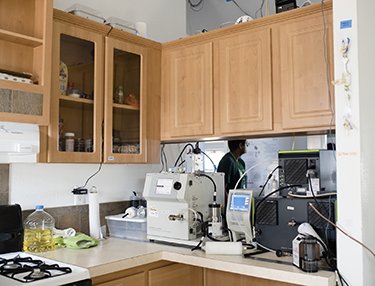Studies show how homes can pollute indoor air
Teams examined emissions from cooking, cleaning, furniture and more

Cooking for Thanksgiving or other holidays releases lots of chemicals into the air. Some are good, and some not so good.
skynesher/E+/Getty Images
WASHINGTON, D.C. — Americans spend roughly 90 percent of their time indoors, the U.S. Environmental Protection Agency notes. During that time, people cook. They clean. They chat, read, play, watch TV and do other things. People also bathe and sleep. And throughout it all, they breathe. New studies find that our activities can pollute the air we breathe indoors. And some of those compounds may harm our health.
Scientists and engineers shared some of their new findings, here, at the annual meeting for the American Association for the Advancement of Science, on February 17.
Both indoors and out, “activities can be a main driver of air quality,” observes Marina Vance. She’s an environmental engineer at the University of Colorado in Boulder. Researchers have studied outdoor air pollution for decades. Indeed, many countries have created laws to limit pollution in outdoor air. But researchers know much less about the pollutants that can be created in reactions between chemicals floating around indoors, Vance says.

To learn more, she and other researchers measured how some everyday activities can affect what chemicals end up in indoor air. To do that, they went to a test house at the University of Texas at Austin. This model home is equipped to measure energy use, how much outdoor air comes in to flush out stale air, and other things related to how buildings function. Vance and her team brought in even more equipment. Then the crew got cooking — literally.
Chef scientists and engineers did all the cooking for a typical U.S. Thanksgiving celebration. They started with a hearty breakfast. Then they prepared a large holiday dinner. Team members roasted a turkey. They baked pies. They stirred up side dishes. Friends came over at dinner time to feast and visit. Then came clean-up time. All along, other team members measured chemicals present in the air.
U.S. laws don’t regulate the air inside people’s homes. But, Vance says, if the house were a little city in the United States, its indoor air “would be very unhealthy for about 5 to 7 percent of the time” on a day like Thanksgiving. That estimate is based on the U.S. Environmental Protection Agency’s Air Quality Index. It’s a gauge that describes the potential riskiness of breathing various types and levels of pollution in outdoor air.
Beyond particulates
That judgment is based only on measurements of “particulate matter,” Vance says. Particulates are teeny bits of pollution. They can harm the heart, cause breathing problems and mess with some brain functions. Indoor readings would be worse in parts of the world where people still cook indoors on wood stoves. Yet the readings from a modern gas range are still cause for concern, she says. Even the heat from an electric stove could create air currents that can spread chemicals from the food throughout a home’s air.

On other days, crew members cleaned the test house with typical household products. At the same time, other team members measured the chemicals these activities spewed into the air. Those results are being analyzed and should be published soon, Vance notes.
In real homes, people also shower or take baths and use personal-care products. Such products include deodorants, nail polish, rubbing alcohol and shampoos. Joost de Gouw is an atmospheric chemist at the University of Colorado in Boulder. Many home products use chemicals called terpenes (TUR-peens) to mimic the smell of trees or other plants. And many terpenes are volatile organic compounds, or VOCs. That means they become gases at room temperature.
Moreover, de Gouw adds, “They’re very reactive.” They easily react with other chemicals in the environment, either on surfaces or in the air. And those reactions can create new chemicals. So the mix of products used in a home, he says, is “something we care about a lot” in terms of the healthiness of indoor air.
Chemicals from personal-care products that make it into the air aren’t always the ones you can smell, he adds. A few years ago, researchers at the University of California, Berkeley, tested the air inside a college classroom. Chemicals called siloxanes (Seh-LOX-ains) were the most common organic chemicals released by the students’ bodies into the air. Those chemicals are common in deodorants, which aim to mask or block odors. The report was in Environmental Science & Technology Letters in 2015.
Furniture and flooring
Home furniture, flooring and other products also can release gases into a home’s air. And some of those can get into kids’ bodies, reports Heather Stapleton. She’s an environmental health scientist at Duke University in Durham, N.C.
In one recent study, she was part of a team that focused on chemicals released into the air by sofas. Their foam cushions had been treated with flame retardants known as PBDEs. Lab tests in animals have linked PBDEs to delays in the animals’ development, to altered hormone levels and to other health problems. New sofas no longer contain PBDEs. But many homes still have furniture that do still have them. Stapleton’s group found higher levels of these chemicals in the blood or urine of children in homes with those types of sofas, compared to kids in homes with PBDE-free furniture.

Her team also looked for evidence of a chemical in vinyl floors: benzyl butyl phthalate (BEN-zul BEU-tul THAAL-ayt). Studies have linked this chemical to breathing problems, skin irritations and other health problems. Children from homes with all vinyl floors had roughly 15 times as much of this chemical in their blood or urine as did kids in homes with no vinyl floors.
The kids may have breathed in some of those chemicals as they slowly escaped — or “off-gassed” — from products. They also probably absorbed some through skin or ingested some from hand-to-mouth contact with tainted dust. “Unfortunately, dust is a sink for many of these chemicals,” Stapleton says. By sink, she means the dust can collect and hold these chemicals.
Home products and furnishings contain many additional chemicals, Stapleton points out. Often, however, products aren’t labelled to identify them, she adds. That makes it hard for scientists to know what to look for when they do research. And it’s even harder for consumers to know what chemicals may be shed by the products they are looking to buy. Ask companies to tell you that information, she says. “Pressure from the public can raise awareness with manufacturers.”
Taking action
There still is much to learn about how chemicals in our homes interact with each other and how they might affect our health, all three researchers said. Meanwhile, they noted, young people and their families can take some steps to limit their exposures.
“Simple things like washing your hands before you eat can reduce exposure to some of these chemicals,” Stapleton says. Washing would remove chemical-laden dust so you wouldn’t eat it with your food. Her family also chose all hardwood floors in their home, because hard surfaces collect less dust than carpets do, she says.
Vance now uses her kitchen’s exhaust fan every time she cooks. She also made sure that it works properly. Opening the windows for ventilation helps from time to time as well. However, there’s a trade-off in energy usage, she notes, if the outdoor air is very warm or very cold. Open windows also won’t help much in areas with high air pollution. Another option: Use a portable air cleaner, which filters particles from the air.
Just getting rid of chemicals probably isn’t the answer, de Gouw says. “Obviously a lot of chemical products serve important purposes.” But researchers are looking to find “greener” substitutes — ones that would be better for health and the environment. People also can choose to “use fewer chemical products,” he suggests. “If you don’t need them, don’t use them.”







